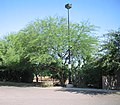Acacia berlandieri
From Gardenology.org - Plant Encyclopedia and Gardening wiki
| Acacia berlandieri subsp. var. | Berlandier's acacia, Guajillo, Plains acacia | |||||||||||||||||||||||||||||||||||||||||||||||||||||||
|---|---|---|---|---|---|---|---|---|---|---|---|---|---|---|---|---|---|---|---|---|---|---|---|---|---|---|---|---|---|---|---|---|---|---|---|---|---|---|---|---|---|---|---|---|---|---|---|---|---|---|---|---|---|---|---|---|

|
|
| ||||||||||||||||||||||||||||||||||||||||||||||||||||||
| ||||||||||||||||||||||||||||||||||||||||||||||||||||||||
Acacia berlandieri (Berlandier Acacia, Guajillo Acacia, guajillo, huajillo) is a shrub native to the Southwestern United States that belongs to the Mimosaceae (wattle family). It grows 1m to 5m tall, with blossoms that are spherical and white, occurring from February through April.[1] The berlandieri epithet comes from the name of Jean-Louis Berlandier[2], a French naturalist who studied wildlife native to Texas and Mexico. A. berlandieri contains a wide variety of alkaloids and has been known to cause toxic reactions in domestic animals such as goats.[3]
Cultivation
Propagation
Pests and diseases
Varieties
Gallery
References
- ↑ University of Texas Native Plant Information Network
- ↑ Holloway, Joel Ellis (2005). A Dictionary of Common Wildflowers of Texas & the Southern Great Plains. Texas Christian University Press. ISBN 354063293X.
- ↑ Clement, Beverly A.; Christina M. Goff and T. David A. Forbes (September 1997). "Toxic amines and alkaloids from Acacia berlandieri". Phytochemistry (Elsevier) 46 (2): 249–254. doi:10.1016/S0031-9422(97)00240-9. http://www.sciencedirect.com/science?_ob=ArticleURL&_udi=B6TH7-3SCB6WX-1N&_user=10&_coverDate=09%2F30%2F1997&_rdoc=1&_fmt=&_orig=search&_sort=d&view=c&_acct=C000050221&_version=1&_urlVersion=0&_userid=10&md5=b215a5ead4e2fc6cc27a4cf30ced3f5e. Retrieved 2007-04-01.
External links
- w:Acacia berlandieri. Some of the material on this page may be from Wikipedia, under the Creative Commons license.
- Acacia berlandieri QR Code (Size 50, 100, 200, 500)




